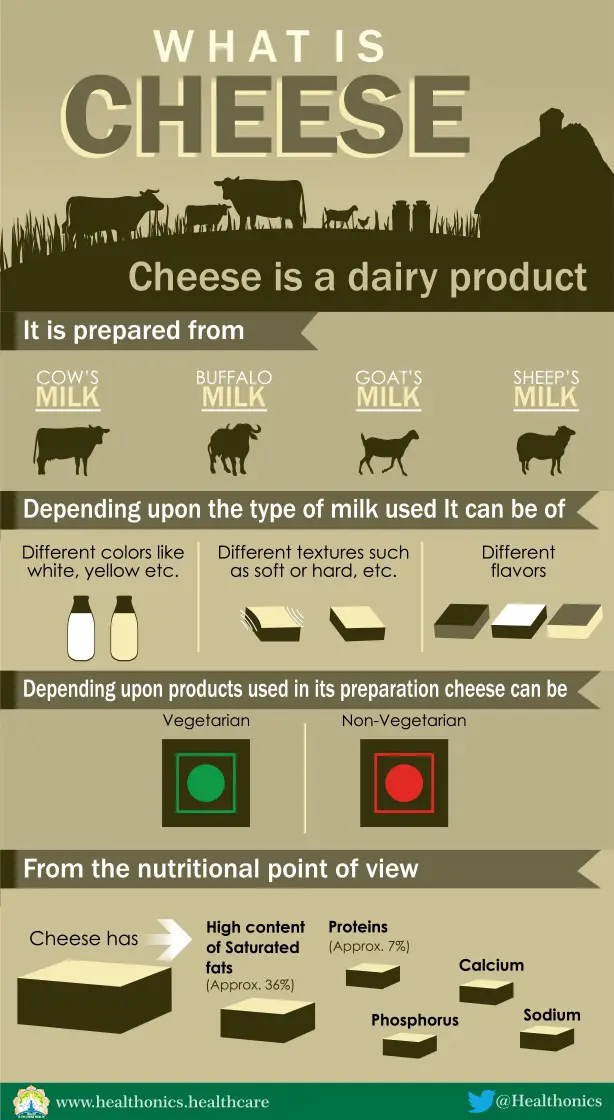- HOME
- DIET
- LIFESTYLE
- Metabolic Syndrome
- Gut Bacteria
- Obesity
- How To Prevent Eye Strain
- Tips To Prevent Back And Neck Pain
- Stress (What It Is? & How To Overcome It?)
- Health problems associated with Sedentary Lifestyle
- Health Benefits Of Sunlight
- Benefits of Regular Walking
- Tips To Prevent Chronic Constipation
- Tips To Prevent Frequent Acidity (Heartburn)
- Diet And Lifestyle Tips To Manage Or Prevent Diabetes
- Health Tips For A Safe And Healthy Monsoon
- Diet And Lifestyle Tips To Manage Or Prevent Hypertension
- Osteoporosis
- INFOGRAPHICS
- HEALTHY RECIPIES
- BMI Calculator
- हिंदी
CHEESE (IS IT VEG OR NON VEG?) - Part 1 - WHAT IS CHEESE?
Wed Dec 19 2018
Everybody loves cheese old and young alike. The sight of molten cheese spread on a Pizza is extremely tempting and very difficult to resist. It is difficult to envisage any of the fast foods like Pizza, pasta, burger without cheese in it. Nowadays even the traditional Indian foods like dosa and samosa have cheese added to them.
So then what exactly is this cheese which we all so adore? Is it a vegetarian product or Non-vegetarian?
Yes you read it right Cheese can either be vegetarian or non-vegetarian. Commercially available cheese packets have a clearly marked Green dot ![]() if vegetarian or Red Dot
if vegetarian or Red Dot ![]() if Non-vegetarian. So how can a dairy product like cheese be veg or non-veg? This is because of the process of cheese making differs in various parts of the world. We shall see the process in detail in the next section but we must know that depending on the products used in preparing the cheese its veg or non-veg status is established. Infact its not just Non-vegetarian rather it uses cow, pig and goat products in making cheese and hence may be considered as religiously unethical by many.
if Non-vegetarian. So how can a dairy product like cheese be veg or non-veg? This is because of the process of cheese making differs in various parts of the world. We shall see the process in detail in the next section but we must know that depending on the products used in preparing the cheese its veg or non-veg status is established. Infact its not just Non-vegetarian rather it uses cow, pig and goat products in making cheese and hence may be considered as religiously unethical by many.
- High content of Saturated fats (Approx. 36%).
- Proteins (Approx. 7%)
- Calcium
- Phosphorus
- Sodium
 HOW CHEESE IS PREPARED FROM MILK?
HOW CHEESE IS PREPARED FROM MILK?
The making of cheese from milk involves following three steps.
- CURDLING
- CURD PROCESSING
- RIPENING
Now let’s understand the process of cheese making.
- CURDLING: [This step determines whether the cheese is Vegetarian or Non-vegetarian]
- It is the first and critical step in cheese making.
- Coagulation of milk takes place at this step.
- Routinely during curdling process either Rennet or vegetable/ microbial enzymes are added to the milk.
- Addition of the enzymes coagulates(curdles) milk by converting milk sugar (lactose) into lactic acid.
- This separates milk into solid curd and liquid whey.
- Whey (liquid) is removed and solid curd is sent for further processing.
- CURD PROCESSING:
- It is the second step in cheese making.
- The solid curd is cut into small cubes to further drain the liquid out of it.
- To make cheese harder the curd is heated at temperature between 35-55 degree centigrade. This pushes more and more liquid (whey) out of the cheese. It also changes the taste of cheese.
- This hardened cheese is then salted for preserving it. Salt also helps in drawing moisture out of it.
- To give cheese its final shape it is pressed hard in the mould or form. Harder the cheese more the pressure applied. Moulds are designed to allow drainage of water since pressure drives the moisture out of the cheese.
- At the end of this stage the curd is unified into single solid body.
- RIPENING/AGEING:
- Freshly made cheese is salty but bland in flavor and rubbery in texture.
- The cheese is then stored under controlled conditions for a period ranging from few days to several years.
- Growth of microbes and enzymes during ripening/ageing process transforms the texture and intensifies the flavor of the cheese.
Cheese can be soft or hard. It also differs on the source of milk used (Cow, Buffalo or goat). It can be of different color, texture and flavor. It does not cause much concern. But the real concern lies in whether the cheese we are eating is vegetarian or non- vegetarian?
Really an important question! But don’t worry we are going to understand the difference between the vegetarian and non-vegetarian cheese and how to identify a vegetarian cheese while buying.



